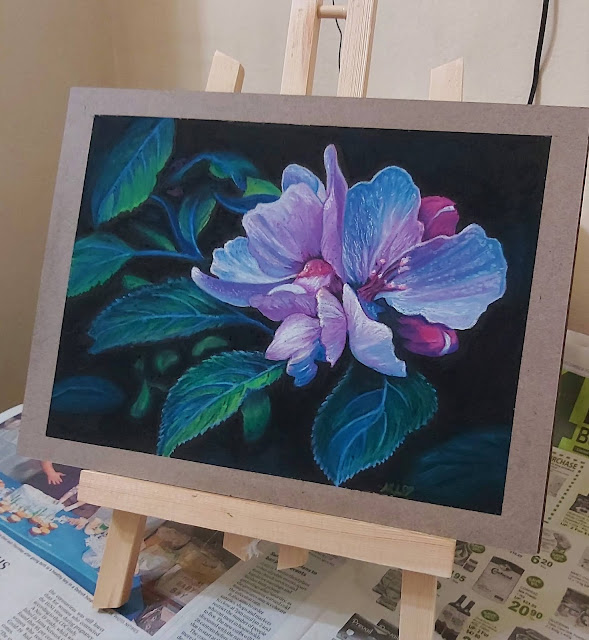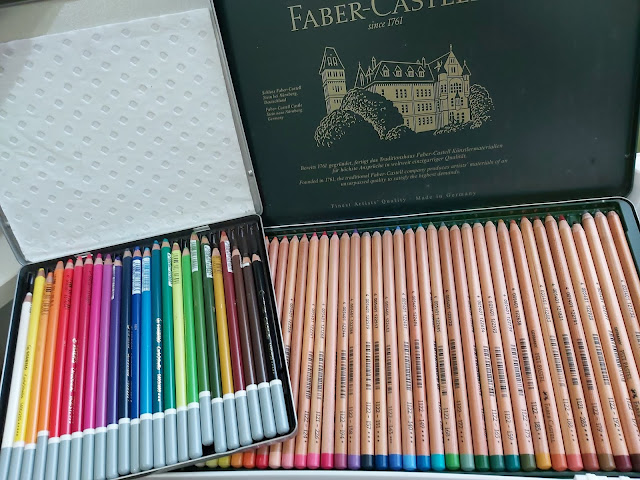Oil pastels for flowers - blending and layering
Call me fickle but oil pastels are my new love ♥
I completed this painting yesterday and I don't think I've loved any of my artworks this much for a while. It's even more special because I was never very good at plants, and never thought I would be...until I discovered that the choice of medium makes all the difference.
With soft pastels, I can't get the level of control I need for delicate petals, whereas with coloured pencils, I have control but I lose the vibrancy of colour. With oil pastels (and coloured pencils for details), I get BOTH.
I haven't used oil pastels a lot so I might not be the best person to give advice. But I've figured out some basics of how they work in terms of blending and layering so I thought I'd share them here.
I have three sets of oil pastels (top to bottom): Sennelier Oil Pastel test pack, Sakura Cray-Pas Expressionist 50pc, Mungyo Gallery Artists' Soft Oil Pastels 48pc. I got the Mungyo and Cray-Pas for super cheap on Amazon, and wanted to add Sennelier since everyone talked about them, but they were expensive so I got only the 6pc test pack.
Layering
When it comes to layering, oil pastels work very similarly to soft pastels. You lay on the hardest sticks first and lay softer ones on top. Also similar to soft pastels, the softer the oil pastel, the more vivid the colour. I'm guessing it's because the softer the pastel, the less filler it has, hence more pigment. In ranking the three brands I have, Cray-Pas is the hardest followed by Mungyo, and Sennelier is the softest, going on like a very creamy lipstick. I often leave Sennelier for the final finishing touches - that white is blindingly bright.
One thing to note though, is that unlike with soft pastels, it's better to work from light to dark. Although you can get light colours to layer on top of dark, especially if they're softer, you run the risk of muddying the colours. For the lightest white highlights, I use the Sennelier white at the end.
The three brands work well together, but I really love the Mungyo (reviewed here). They're so soft and create hardly any crumbs. Since the colour payoff is fantastic, much better than the Cray-Pas, I decided to use them for the flower. Once I laid down the blues and purples, I knew I was on to something wonderful. The colours are just so vivid and they pop.
When it came to the leaves, I didn't want them fighting for attention with the flower, so I used primarily Cray-Pas, whose colours are more muted. Cray-Pas is also drier and creates more crumbs, but I like to use it for backgrounds so as not to use up so much of Mungyos for large areas. If you use a heavy hand, you can go through oil pastels pretty quickly! The great thing about oil pastels is you don't need special paper. Just regular Canson Mi-Teintes works fine and can take quite a lot of layers.
Blending
Blending is where oil pastels differ from soft pastels. Oil pastels aren't as smudgy, which is why I get better control with them. For someone who tends to use a heavy hand, this is great. To smoothen one colour into the next, especially for the flower, I use a blending stump. Some artists use cotton buds, they both work. The Cray-Pas set comes with two colourless blenders but I don't like them much - they tend to muddy the colours. I only use them for large dark areas where I don't need to maintain the luminosity of hues.
What I found is that for large areas like the leaves, I could easily blend and even mix colours by just using two different hues on top of each other. The trick is not to be afraid to layer on the pigment thickly. I used a dark green, followed by a topping of dark blue to get that nice blue-green. Merging some of the leaves into the black background was also easy. Just roughly go over the outline with a dark blue oil pastel and it all blends nicely together.
What I noticed, however, was that paper matters. I first discovered the wonderful blending properties of oil pastels when I drew this flower on Canson Mi-Teintes.
However, when I tried to draw tulips on Canson Black Drawing paper, the colours wouldn't go on smoothly. The Cray-Pas, especially, went on very patchy and it was difficult to blend the pigment.
The final drawing was ok but only after I switched to purely Mungyo. I also couldn't get the white coloured pencil to draw on top of the oil pastels and had to use a white gel pen for the water droplets.
Below is the flower after I've used coloured pencils to sharpen the edges and define some of the outlines. It really does add depth to the drawing.
And this is the final painting.
We often think that artists have pet subjects and find a medium that they love to bring these subjects to life, but for me, this was completely reverse. It's not an exaggeration to say that discovering oil pastels has made me fall in love with drawing flowers - something I previously didn't have an ounce of interest in. What is art but a series of experiments, and I'm so glad I stumbled onto this one.















ReplyDeleteYou have provided a nice article, Thank you very much for this one. And I hope this will be useful for many people. And I am waiting for your next post keep on updating these kinds of knowledgeable things